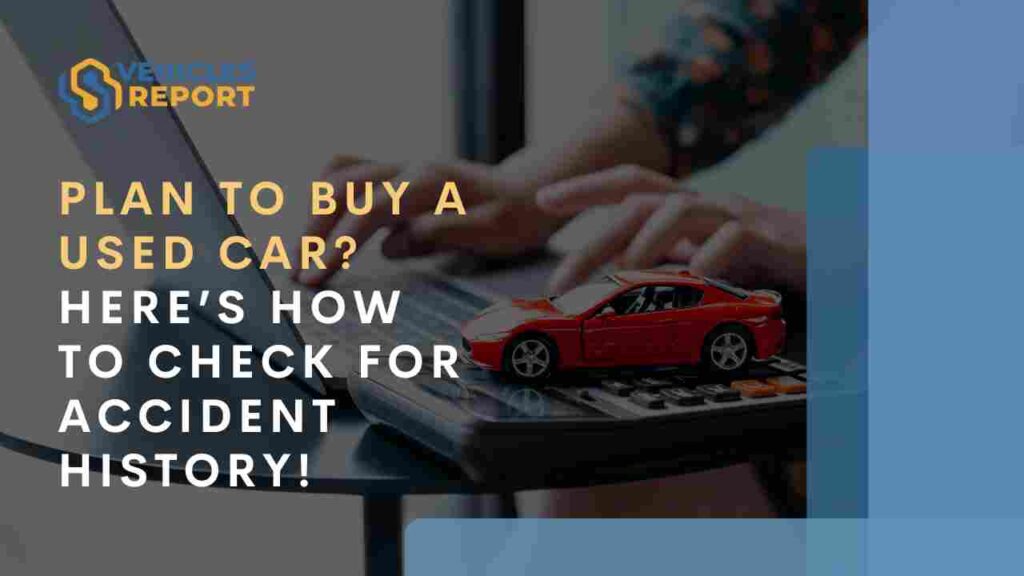Imagine you are looking for a secondhand car that matches your budget and your style, and you want to purchase the vehicle right away without checking anything related to that car, especially checking on the accident history; an unrevealed accident history could turn a bargain into a nightmare. Buying a used vehicle without knowing its record could lead to safety issues and unpredictable fixing costs.
With some know-how and the right tools, you can avoid these pitfalls. This guide will walk you through the steps to check if a car has been in an accident and show you how services like Vehicles Report can help ensure you make a smart purchase.
Why Accident History Matters When Buying Used Cars?
Understanding a car’s record is vital in many aspects, including safety reasons, as you don’t want to be involved in an accident because something happened to your vehicle. When a car has been in an accident, it may have structural damage that is not immediately visible as it may have been under the body of the car. Issues like a bent frame or compromised safety features can jeopardize the vehicle’s safety. Even minor accidents can lead to alignment problems or faulty airbag deployment in future crashes.
Beyond safety, the financial aspect should also be considered. A car with a record of accidents may resell at a lower value on the market; sometimes, it also requires more frequent and costly repairs. In some cases, it’s hard to get insurance to cover the car due to its accident history reports. Knowing a car’s history before buying can save you from costly surprises and accidents.
Physical Signs That a Car May Have Involved in an Accident
A physical inspection is one of the easiest ways to determine whether a car was involved in an accident. Even without special knowledge, we can easily spot a thing or two on the car’s body that indicates the accident reports.
Paint Job
Inconsistent texture can indicate that the car has been involved in an accident. Mismatched paint colors or uneven texture can indicate repairs after an accident. It’s common for repainted areas to stand out, especially if the work was done hastily. Examine the car in bright or direct sunlight for the best visibility.
Body Panels
Pay attention to the gaps between doors, hood, and trunk. If the gaps are uneven, the car’s frame has been bent or repaired improperly. Also, check the alignment of the panels. A door that doesn’t close flush or a crooked trunk may indicate previous damage.
Condition of Certain Parts of the Car
New-looking components on an older vehicle, such as headlights, bumpers, or fenders, could signal that these parts were replaced after an accident. Rust or missing fasteners in the engine bay can also suggest hasty repairs.
Inspect the Undercarriage
Finally, the undercarriage is the last part you should pay attention to. Lift the car or peek underneath to check for scrapes, dents, or signs of welding. These can indicate collision damage that wasn’t correctly fixed.
Using a VIN Check to Uncover the Car Past Records
While physical inspection could provide some evidence of the car’s history of accidents, always look for other evidence. A comprehensive VIN check could give you detailed information about the vehicle, so it’s the safest and easiest way to check the records of the car you are going to buy.
The Vehicle Identification Number (VIN) is a unique 17-character code that acts as the vehicle’s fingerprint. It can be found on the dashboard, in the driver’s side door frame, or in vehicle documents.
Running a comprehensive VIN Check with Vehicle Reports provides access to a detailed car history, including accident records, salvage titles, and insurance claims. This information can reveal if the vehicle was involved in a major accident, whether an insurer wrote it off, or whether it was repaired after a collision.
A VIN check can also help verify that the car’s title is clean. A “salvage title” indicates that an insurance company deemed the car a total loss, usually due to severe damage. Knowing this before purchase can prevent costly surprises and protect your investment.
Other Sources for Checking Accident History
Other ways exist to investigate a car’s accident history besides visual inspections and VIN checks. One option is to review past repair records. Ask the seller if they have maintenance logs or service records. Consistent entries from the same repair shop can indicate regular maintenance, but frequent bodywork could be a red flag.
You can also consult insurance databases. In some regions, insurers maintain records of accidents, especially when a claim has been filed. This information can be obtained online or by contacting the insurance company directly.
Finally, speak with the previous owner. They may provide insights into incidents or repairs not reflected in official records. However, not all sellers willingly disclose this information, so tools like the Vehicles Report are crucial.
Benefits of Using Vehicles Report for Accident Checks
Vehicles Report offers a comprehensive and user-friendly solution for checking a car’s accident history. Their services provide a deep dive into the vehicle’s past, helping you uncover details that might not be visible during a physical inspection.
The benefits of using Vehicles Report include:
- Comprehensive Data
Their reports compile information from reliable sources, including insurance claims, salvage auctions, and repair records. This gives you a complete picture of the car’s history.
- Accurate and Up-to-date Information
Vehicles Report updates its data regularly, ensuring you get the most current information about the vehicle.
- Ease of Use
Simply enter the VIN or license plate number to access a detailed report in minutes. It’s a hassle-free way to verify a car’s accident history before you buy.
- Peace of Mind
The Vehicles Report can help you avoid purchasing a car with hidden damage, ensuring a sound investment.
Additionally, their window sticker service provides a breakdown of the car’s original features and specifications, which can help verify whether any parts have been replaced after an accident.
When buying a used car, ensuring that it hasn’t been involved in an accident is crucial for your safety and financial well-being. While a physical inspection can provide some clues, the most reliable way to check a car’s history is by using a VIN check from a trusted service like Vehicles Report.
With detailed accident records, title information, and other critical data, you can make an informed decision and avoid costly surprises. Before purchasing, take advantage of available resources, such as Vehicles Report, and drive off confidently.








